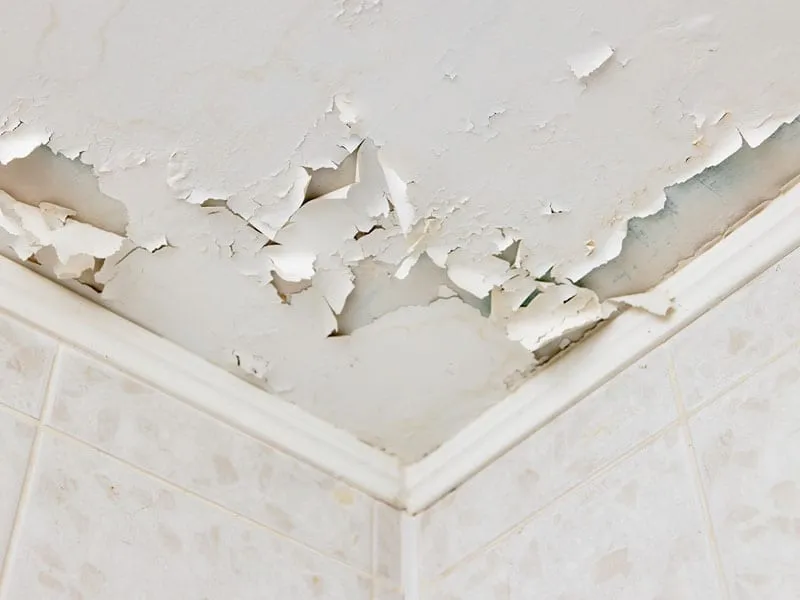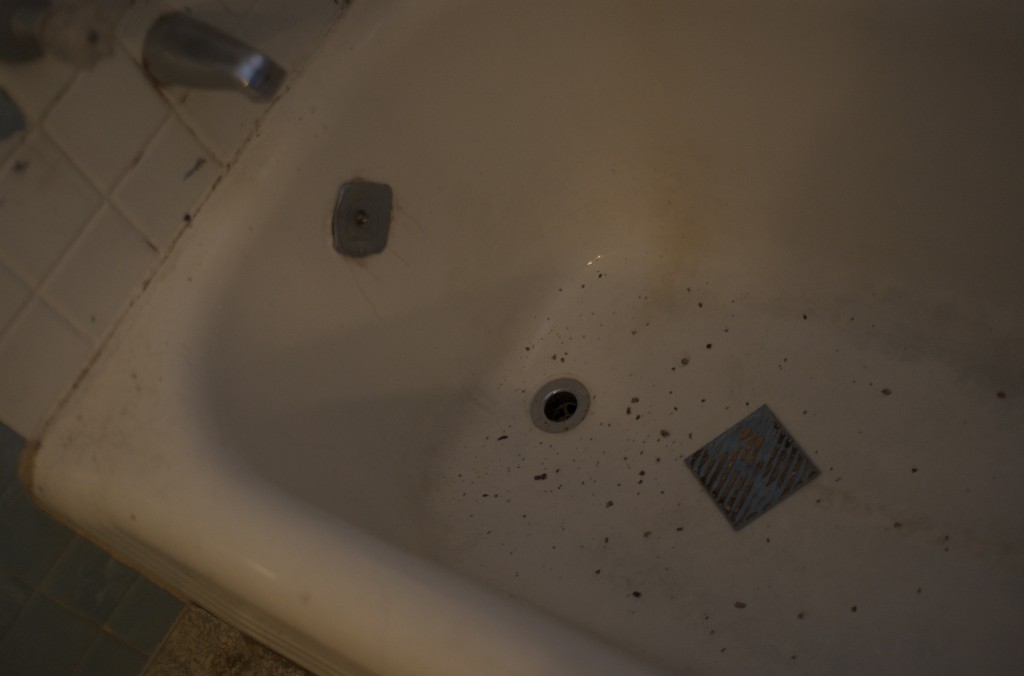Causes of Bathroom Floor Paint Failure

A bathroom floor is a challenging environment for paint due to the constant presence of moisture, humidity, and foot traffic. Paint failure can occur for various reasons, often due to improper preparation, using the wrong paint type, or neglecting essential steps in the application process. Understanding these causes is crucial for ensuring a durable and long-lasting paint finish.
Improper Surface Preparation
Thorough surface preparation is critical for paint adhesion and longevity. Neglecting this step can lead to paint peeling, chipping, and premature failure.
- Cleaning: The bathroom floor must be thoroughly cleaned to remove dirt, grime, soap scum, and any residues that can interfere with paint adhesion. This includes removing mildew and mold with a bleach solution and allowing the floor to dry completely before proceeding.
- Sanding: Sanding the floor with fine-grit sandpaper helps create a rough surface that promotes better paint adhesion. This step is particularly important for glossy or previously painted surfaces.
- Priming: Applying a primer specifically designed for bathroom floors is crucial. Primers help seal the surface, enhance paint adhesion, and provide a uniform base for the paint. Choosing a primer that is moisture-resistant and mildew-resistant is essential for bathroom environments.
Using the Wrong Type of Paint, Bathroom floor painted falling
Selecting the right paint for a bathroom floor is crucial. Choosing a paint that lacks moisture resistance or poor adhesion can lead to paint failure.
- Moisture Resistance: Bathroom floors are constantly exposed to moisture and humidity. Choosing a paint that is specifically formulated for high-moisture environments is crucial. Look for paints labeled as “moisture-resistant,” “water-based,” or “alkyd-based.”
- Adhesion: The paint should adhere well to the bathroom floor surface. Look for paints labeled as “high-adhesion” or “epoxy-based” for improved adhesion.
Paint Application Issues
Applying paint too thickly or thinly can lead to problems.
- Applying Paint Too Thickly: Applying paint too thickly can prevent it from drying properly, leading to cracking, peeling, and a uneven finish. It’s important to apply thin, even coats, allowing each coat to dry completely before applying the next.
- Applying Paint Too Thinly: Applying paint too thinly may result in poor coverage and a less durable finish.
Inadequate Drying Time
Allowing adequate drying time between coats is essential.
- Drying Time: Each coat of paint needs sufficient time to dry completely before applying the next coat. Applying the next coat too soon can lead to a sticky surface, uneven finish, and reduced durability. Consult the paint manufacturer’s instructions for recommended drying times.
Exposure to Excessive Moisture or Humidity
Bathrooms are inherently humid environments, and excessive moisture can cause paint to fail.
- Ventilation: Adequate ventilation is crucial for reducing humidity levels in the bathroom. Ensure proper ventilation by using an exhaust fan during and after showering.
Identifying Signs of Paint Failure

Identifying signs of paint failure on bathroom floors is crucial for addressing the problem before it worsens and leads to more extensive repairs. These visual cues can indicate underlying issues that need attention.
Visual Indicators of Paint Failure
Several visual indicators can signal paint failure on bathroom floors. These signs can help you identify the problem and determine the appropriate course of action.
- Peeling, chipping, or cracking paint: This is a common sign of paint failure, particularly in high-traffic areas. It can occur due to poor adhesion, improper preparation, or exposure to moisture.
- Discoloration or fading: Paint can fade or discolor over time, especially in areas exposed to sunlight or moisture. This can indicate that the paint is breaking down and no longer providing adequate protection.
- Blistering or bubbling: Blisters or bubbles in the paint can indicate trapped moisture beneath the surface. This can happen due to improper ventilation, moisture trapped under the paint, or inadequate surface preparation.
- Mold or mildew growth: Mold or mildew can thrive in damp environments, and bathroom floors are particularly susceptible. If you see mold or mildew on the painted surface, it’s a sign of moisture problems and potential paint failure.
Differentiating Paint Failure from Other Issues
While paint failure is a common concern, it’s important to differentiate it from other potential issues that might affect your bathroom floor.
- Grout problems: Cracked, discolored, or missing grout can make the floor look unsightly but may not necessarily indicate paint failure. If the paint is intact, the problem lies with the grout.
- Damaged tiles: Cracked or chipped tiles are a separate issue from paint failure. They require replacement, not repainting.
Table Outlining Signs of Paint Failure and Potential Causes
The following table provides a summary of common signs of paint failure and their potential causes:
| Sign of Paint Failure | Potential Causes |
|---|---|
| Peeling, chipping, or cracking paint | Poor adhesion, improper surface preparation, moisture exposure, inadequate paint quality |
| Discoloration or fading | Sunlight exposure, moisture exposure, paint degradation, improper cleaning products |
| Blistering or bubbling | Trapped moisture, inadequate surface preparation, poor ventilation, temperature fluctuations |
| Mold or mildew growth | High humidity, poor ventilation, water leaks, inadequate cleaning |
Remedies for Painted Bathroom Floors: Bathroom Floor Painted Falling

Repainting a bathroom floor can be a cost-effective way to refresh the look of your bathroom, but it requires careful preparation and maintenance to ensure its longevity. If your painted bathroom floor is showing signs of damage, such as peeling, cracking, or discoloration, there are several remedies you can use to restore its appearance and protect it from further deterioration.
Stripping and Repainting the Floor
Stripping and repainting the floor is the most comprehensive approach to restoring a damaged painted bathroom floor. This method involves removing the existing paint layer and applying a fresh coat of paint.
- Surface Preparation: Before stripping the paint, ensure the floor is clean and free of debris. You can use a mild detergent and water to clean the floor.
- Stripping the Paint: Use a paint stripper specifically designed for bathroom floors. Apply the stripper according to the manufacturer’s instructions and allow it to sit for the recommended time.
- Cleaning the Floor: After stripping the paint, thoroughly clean the floor to remove all traces of stripper and paint.
- Applying Primer: Apply a primer specifically designed for bathroom floors. Primer helps to create a smooth surface for the paint to adhere to.
- Painting the Floor: Apply two coats of bathroom floor paint, allowing each coat to dry completely before applying the next.
Patching and Repairing Areas of Peeling or Cracking Paint
If only small areas of the paint are peeling or cracking, you can patch and repair them instead of stripping and repainting the entire floor. This method is less time-consuming and less expensive than stripping and repainting.
- Scrape Away Loose Paint: Use a scraper to remove all loose paint from the affected area.
- Clean the Area: Clean the area with a damp cloth to remove any remaining debris.
- Apply Patching Compound: Use a patching compound specifically designed for bathroom floors. Apply the compound according to the manufacturer’s instructions and allow it to dry completely.
- Sand the Patch: Once the patching compound is dry, sand it smooth with fine-grit sandpaper.
- Prime the Patch: Apply a primer to the patched area.
- Paint the Patch: Apply two coats of bathroom floor paint to the patched area, allowing each coat to dry completely before applying the next.
Applying a Sealant to Protect the Paint from Moisture
Applying a sealant to the painted bathroom floor can help to protect the paint from moisture and extend its lifespan.
- Choose a Suitable Sealant: Select a sealant specifically designed for bathroom floors. Look for a sealant that is waterproof and durable.
- Prepare the Floor: Ensure the floor is clean and dry before applying the sealant.
- Apply the Sealant: Apply the sealant according to the manufacturer’s instructions.
Bathroom floor painted falling – A painted bathroom floor, while initially stylish, can quickly become a maintenance nightmare. Chips and scratches are inevitable, and the constant moisture can lead to peeling and cracking. To elevate your bathroom design and ensure longevity, consider incorporating modern accessories.
A modern bathroom accessories list will not only enhance functionality but also complement your overall aesthetic. For a truly timeless look, opt for durable materials like porcelain or stainless steel that can withstand the daily wear and tear of a bathroom environment.
A freshly painted bathroom floor can be a beautiful addition, but if the paint starts to peel or chip, it can quickly become an eyesore. To distract from the imperfections, consider incorporating some beautiful moroccan inspired bathroom accessories like intricate tile designs or colorful woven rugs.
These vibrant elements can draw the eye away from the damaged floor, creating a more visually appealing space.